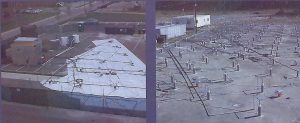EPA to begin Atlantic PCE contamination mitigation in February
January 24th, 2017 by Ric Hanson
Officials with the Environmental Protection Agency and the Agency for Toxic Substances and Disease Registry/CDC, Tuesday evening, made a presentation to about 25 people at the Cass County Community Center in Atlantic, with regard to PCE (Tetrachloroethylene) groundwater contamination and vapor intrusion from two separate former dry cleaning sites in town. The former Norge Dry Cleaning site near 7th and Plum Streets, was placed on the “National Priorities List (NPL)” for clean-up, in April 2016. EPA Superfund monies are being used for the process.
Bo Hull, Remedial Project Manager for the EPA’s Region 7 office in Kansas City said when a site is place on the NPL, that means there’s a problem. Susan Fisher, On-Scene Coordinator with the EPA’s Region 7 office in Kansas City, has previously stated that for the past several years, the agency has been assessing the groundwater in Atlantic, and found one area in particular to be contaminated with PCE, which is a manufactured chemical typically used in dry cleaning solvents.
The chemical PCE – a known carcinogen — was originally detected in 1982, when routine monthly sampling of an Atlantic Municipal Utilities (AMU) well resulted in the discovery of PCE. The well was immediately taken off line and pumped to the Wastewater Treatment Plant. Research then began on where the contaminant was coming from. Once the site was located, the process began to determine the extent of contamination and how to mitigate the impact. In the former dry cleaners parking lot, they found a high contamination of PCE in the soil. It extended below the soil into the Dakota Sandstone, a depth of about 40-feet.
The affected well, AMU 7, is old and failing. As a result, the contamination was moving towards the AMU 6 well. That well showed contamination and is no longer being pumped for drinking water purposes. In June 2015, when 7th Street was being torn up and resurfaced, the EPA Clean-up team removed about 45 truckloads of contaminated soil from under the street near the former dry cleaner site and replaced it with clean soil.
Last year, the EPA worked on finding a remedy to remove the source area of contamination, and came up with the idea of using TRS Electrical Resistance Heating (ERH), or in situ thermal remediation.
The work is expected to begin around February 21st. It’ll take three months for the ERH system installation and once on-line, it’ll run for about nine months. The entire process therefore, takes about a year. Once the source contamination is removed, the EPA will begin on removing the remaining plume that stretches about a half mile south through 3rd Street Place and Mulberry Streets. A ground water containment system including two extraction wells, will be installed south of the railroad tracks, near 3rd Street Place and Mulberry.
A second, separate PCE site on Chestnut Street was discovered in 2015 by sub-slab soil sampling and/or air sampling from several buildings along Chestnut. Officials say that was likely the result of six dry cleaning businesses that were in operation in the downtown area since the 1930’s. The samples showed elevated levels of PCE and TCE (Trichoroethylene), which is also sometimes associated with dry cleaning, metal degreasing and textiles. Under certain circumstance, officials said TCE can degrade and break down into PCE. The primary issue with the Chestnut Street site is what’s called “Vapor Instrusion,” which is when vapors come from the contaminated soil and groundwater to the ground surface via cracks in basements and foundations.
Of the 73 properties downtown, nine were identified as having “Elevated concentrations” of PCE/TCE. Vapor mitigation systems [VMS] (Similar to those for eradicating radon), were installed. No other properties to date have been identified as needing a VMS. Current studies show no portion of the City’s drinking water or private wells have been affected by the downtown PCE/TCE issue. The EPA will continue sampling of properties next week along Chestnut Street. Soil sampling will also be conducted. An EPA clean-up will be based on those results.
The total cost of the cleanup is estimated at $1.5-million dollars. Again, officials stress that the City’s of Atlantic drinking water wells are NOT affected by the PCE, and the water is safe to drink. Additional information is available online at https://www.epa.gov/superfund/pceformerdrycleaner






